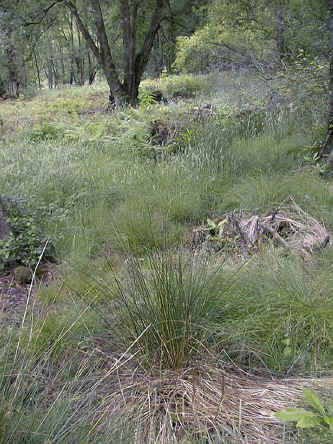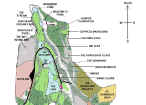The Wet Woodland Plant Survey
General Introduction
 |
A marshy area within the Wet Woodland. |
What is a Wet Woodland Habitat? Wet Woodland is a natural habitat native to South West England that has soil with varying degrees of moisture content. It usually has some standing water. It is characteristically dominated by moisture loving plants such as willow and alder trees, sphagnum mosses, sedges and rushes. Where is The Wet Woodland?
The Wet Woodland that is the subject matter of this survey incorporates a group of distinctive wildlife areas within a Wet Woodland habitat at the western end of the Woodland Education Centre, near Honiton, East Devon in South West England. The Woodland Education Centre is a 50 acre reserve owned by the Forestry Commission and managed in partnership with the Offwell Woodland & Wildlife Trust. It lies within a steep sided, south facing wooded valley and contains many different wildlife habitats native to Britain. An active programme of wildlife conservation and education is conducted at the Centre. The Local Environment Agency Plan (LEAP) for the River Axe and Lim catchment lists Wet Woodland in the area as a Nationally Important Key Habitat. According to the LEAP, Wet Woodland supports rich communities of invertebrates which in turn supports many other animals including the Pipistrelle bat, a species currently in decline. Wet Woodland is also an important habitat for lichens which are also in decline. Wet Woodland is locally under threat from clearance, grazing pasture, inappropriate management and air pollution. At the Woodland Education Centre, the six distinct areas included in the Wet Woodland are: 1) Wet seepage area What is The Wet Woodland Like? Situation & Geology The Wet Woodland is situated on a gentle east facing slope which is protected from the prevailing south westerly wind. On the upper slopes of the Wet Woodland, much of the ground below the thin top soil is greensand based, with cherts. Seams of these cherts sometimes become exposed at the surface as areas of loose rubble resembling a shingle beach. Yet even in this inhospitable environment, some plants are able to get a loose foothold and grow successfully. A species of non-native cherry grows in profusion in these stony areas. Surrounding the Wet Woodland to the north and west is a large area of mature deciduous woodland, while to the east is an area of damp alder and willow carr either side of the Offwell Brook. To the immediate south of the Wet Woodland lies an open area of restored heathland. The soil here is shallow and has an acid pH. During the course of management, many heathland plant species have returned to this area as the habitat has been recreated. See the Heathland Restoration Project for more information. Rainfall & pH Wet Woodland is usually found in areas which have a high annual rainfall. The average annual rainfall in the parish of Offwell surrounding the Wet Woodland is 47", with a range of 35" - 65". (These figures are based on data collected over 35 years by Mr & Mrs Hall of Offwell). Soil pH measurements were carried out in 1997 in the Heathland immediately south of the Wet Woodland. The pH values obtained varied from 4.0 - 5.0 across the area, indicating acid soils. In the adjacent Wet Woodland, a lack of alkaline-loving plants such as European Ash Fraxinus excelsior and Hart's Tongue Fern Phyllitis scolopendrium suggest that the soil here is also likely to have acid pH values. Both European Ash and Hart's Tongue Fern are present at the Woodland Education Centre where the soil is alkaline. |
